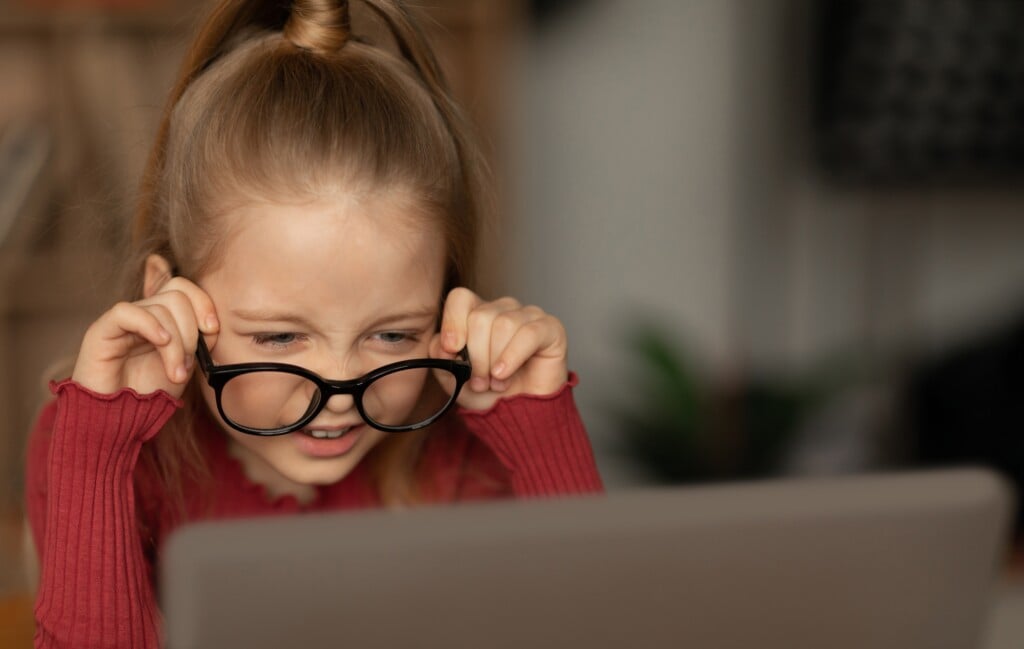Can Your Child See?
If the blackboard is a blur this fall, trouble lies ahead. But regular checks with an eye-care professional can help.

One in four U.S. children ages 2 to 17 wears corrective lenses, according to the Centers for Disease Control and Prevention. And other kids ought to be wearing them but aren’t—yet. Vision problems at an early age can adversely affect how a child learns in the classroom and interacts with other students, and they’re also a safety concern.
As schools reopen this fall, eye specialists like ophthalmologists and optometrists, such as Monmouth Eye Care in Tinton Falls and Precision Eyecare in Red Bank, can guide parents as kids prepare to head back to class in September:
• Recognize symptoms. Let’s face it—some kids, especially the youngest ones, may not communicate that they’re having trouble seeing, either at home or in the classroom. They may be embarrassed to say they can’t see properly, or they may not even realize that their vision isn’t clear. Vision problems in children aren’t always obvious so it’s important for parents, teachers, brothers and sisters to closely observe kids as they’re growing. Parents should be on the lookout for symptoms such as squinting or holding reading materials very close to the face. They can be subtle indicators of impaired vision, but they’re frequently missed signs. Blurred vision can also be accompanied by frequent headaches, a short attention span and coordination difficulties.
• Get kids tested. Just as you’d take your child to a pediatrician for a back-to-school checkup, take her or him for a routine eye exam with an ophthalmologist or an optometrist. Many parents believe that school screenings are the same as comprehensive eye exams, but even with 20/20 vision, your child may still have problems that can only be detected by an experienced eye doctor. The American Optometric Association recommends that kids receive their first eye exam between 6 and 12 months, followed by another exam at 3 years, then exams every other year while they are in school. Kids with impaired vision often have one of three conditions: myopia (nearsightedness), hyperopia (farsightedness) or astigmatism (partial blurred vision caused by imperfect curvature of the eye). Other common eye problems are amblyopia, or lazy eye, and strabismus, when the eyes are not properly aligned. Eye doctors can recommend treatment or correction for each of the conditions.
• Choose correct correction. In most cases, children with impaired vision will be fitted for glasses. (Parents can have fun with kids by letting them pick out their frames!) For older kids, especially those who play sports, contact lenses are another correction option. Children as young as 8 years old can do well with contacts, but it’s really up to the parents and the patient, as daily placement of the contacts on the eye—which includes keeping lenses and hands clean—and regular maintenance require a high level of responsibility. That said, most eye care providers won’t recommend contacts for children younger than age 12, as the risks often outweigh the benefits in younger children.
Meanwhile, your child’s celebrity idol may tout the benefits of corrective eye surgery, but procedures such as lasik are not FDA-approved for patients under 18. Because the cornea can still be in a developing stage even in a patient’s late teens, most eye-care professionals won’t recommend surgery until a person reaches 21.
• Be wise with kids’ eyes. Eye care goes beyond correcting impaired vision, and it’s up to a parent or guardian to ensure that kids are maintaining proper health to keep sharp. Children should take regular breaks to prevent digital eyestrain. Keep in mind the 20-20-20 rule, which suggests that an individual look at something 20 feet away for 20 seconds every 20 minutes. This practice can help reduce eye fatigue and keep eyes healthy. Prolonged exposure to ultraviolet lights has been linked to ocular disease later in life, so most experts recommend that children wear sunglasses as part of their regular outdoor protection routine. Protective eyewear also is recommended when kids play contact sports or sports involving potentially sharp equipment. Parents should also limit a child’s exposure to household chemicals, detergents and cleaners, many of which can irritate eyes.
EYES HUNGRY?
If you’re looking for a diet that is good for ocular health, the American Academy of Ophthalmology recommends emphasis on:
• Orange-colored vegetables for vitamin A: carrots, sweet potatoes, cantaloupe, apricots
• Fruits and vegetables for vitamin C: oranges, tangerines, grapefruit, lemons, peaches, red bell peppers, tomatoes, strawberries
• Leafy greens: spinach, kale, romaine lettuce
• Foods rich in vitamin E: avocados, almonds, sunflower seeds
• Fish with omega-3 fatty acids: salmon, tuna, sardines, trout
SEEING AN EYE SPECIALIST?
There are several types of eye doctors and specialists who can help you with your vision. Before you go, it’s important to know the differences between each expert. Here’s a quick guide:
Ophthalmologist
This specialist is a medical doctor (M.D.) or a doctor of osteopathy (D.O.) with advanced eye-care training who offers complete eye care, from exams to diagnoses of diseases. In addition, an ophthalmologist is licensed to practice medicine and surgery and can perform surgical care for issues such as cataracts, trauma, childhood eye conditions and glaucoma.
When to see one: general eye care, management of eye diseases and conditions, medical intervention
Medical Optometrist
Also a doctor of optometry, this specialized clinician has additional training through residency programs focused on eye disease and conditions. They can provide complete eye care but primarily focus on medical care for eyes, assessing eye health, monitoring and diagnosing diseases.
When to see one: general eye care, annual medical eye exam
Optometrist
This professional is a doctor of optometry (O.D.) known for expertise in providing vision correction and care, though they also can diagnose, treat and manage eye diseases and disorders.
When to see one: general eye care, eye checkups, vision tests and eyeglass or contact lens prescriptions
Optician
These technicians are trained to design, verify and fit eyeglass lenses and frames, contact lenses and other devices to correct eyesight. They use prescriptions supplied by ophthalmologists or optometrists.
When to see one: glasses and contact lens fitting
Sources: New Jersey Department of Consumer Affairs and American Academy of Ophthalmology

